CHCECE016: Establishing and Maintaining a Safe and Healthy Environment
VerifiedAdded on 2023/06/04
|29
|4159
|165
Homework Assignment
AI Summary
This assignment focuses on the CHCECE016 unit, which emphasizes the importance of establishing and maintaining a safe and healthy environment for children in early childhood education settings. The assignment requires the student to demonstrate their understanding of various safety and health policies and procedures, including workplace safety, hand washing, care of equipment, cleaning, handling dangerous products, food preparation, nappy changing, communication with stakeholders, medication management, first aid, and child protection. The student is tasked with locating relevant policies and procedures within their workplace, answering questions related to safety practices, and providing information about immunizations. Additionally, the assignment includes reviewing the service's play area, creating a floor plan, and analyzing different areas within the environment, considering factors such as age groups, types of experiences, and levels of supervision. The student also has to identify the locations of various procedures, such as emergency procedures, hand washing, warning signs, and emergency numbers, within the service. Finally, the student is required to conduct a checklist assessment with colleagues to gauge their awareness of health and safety responsibilities.
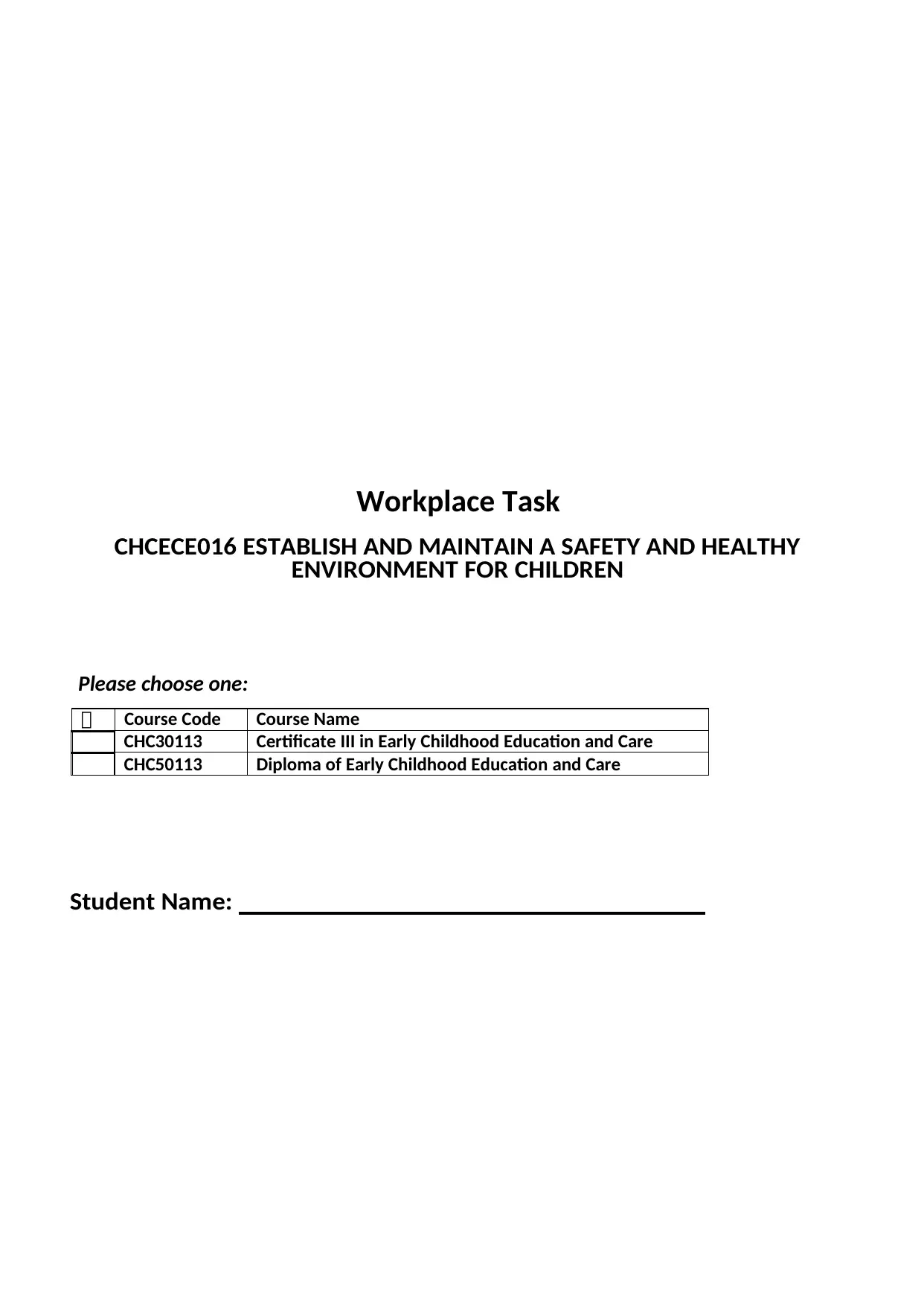
Workplace Task
CHCECE016 ESTABLISH AND MAINTAIN A SAFETY AND HEALTHY
ENVIRONMENT FOR CHILDREN
Please choose one:
Course Code Course Name
CHC30113 Certificate III in Early Childhood Education and Care
CHC50113 Diploma of Early Childhood Education and Care
Student Name:
CHCECE016 ESTABLISH AND MAINTAIN A SAFETY AND HEALTHY
ENVIRONMENT FOR CHILDREN
Please choose one:
Course Code Course Name
CHC30113 Certificate III in Early Childhood Education and Care
CHC50113 Diploma of Early Childhood Education and Care
Student Name:
Paraphrase This Document
Need a fresh take? Get an instant paraphrase of this document with our AI Paraphraser
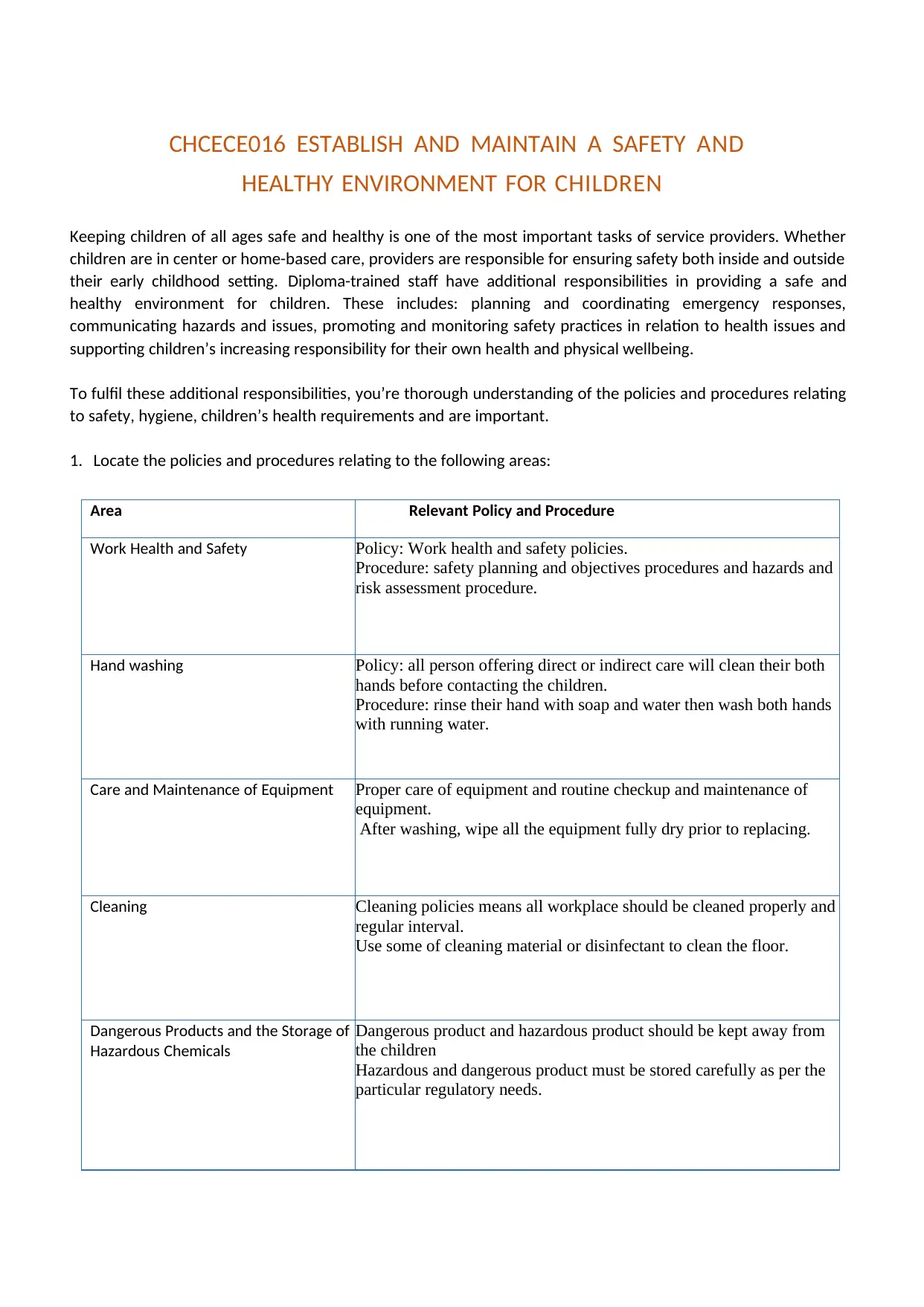
CHCECE016 ESTABLISH AND MAINTAIN A SAFETY AND
HEALTHY ENVIRONMENT FOR CHILDREN
Keeping children of all ages safe and healthy is one of the most important tasks of service providers. Whether
children are in center or home-based care, providers are responsible for ensuring safety both inside and outside
their early childhood setting. Diploma-trained staff have additional responsibilities in providing a safe and
healthy environment for children. These includes: planning and coordinating emergency responses,
communicating hazards and issues, promoting and monitoring safety practices in relation to health issues and
supporting children’s increasing responsibility for their own health and physical wellbeing.
To fulfil these additional responsibilities, you’re thorough understanding of the policies and procedures relating
to safety, hygiene, children’s health requirements and are important.
1. Locate the policies and procedures relating to the following areas:
Area Relevant Policy and Procedure
Work Health and Safety Policy: Work health and safety policies.
Procedure: safety planning and objectives procedures and hazards and
risk assessment procedure.
Hand washing Policy: all person offering direct or indirect care will clean their both
hands before contacting the children.
Procedure: rinse their hand with soap and water then wash both hands
with running water.
Care and Maintenance of Equipment Proper care of equipment and routine checkup and maintenance of
equipment.
After washing, wipe all the equipment fully dry prior to replacing.
Cleaning Cleaning policies means all workplace should be cleaned properly and
regular interval.
Use some of cleaning material or disinfectant to clean the floor.
Dangerous Products and the Storage of
Hazardous Chemicals
Dangerous product and hazardous product should be kept away from
the children
Hazardous and dangerous product must be stored carefully as per the
particular regulatory needs.
HEALTHY ENVIRONMENT FOR CHILDREN
Keeping children of all ages safe and healthy is one of the most important tasks of service providers. Whether
children are in center or home-based care, providers are responsible for ensuring safety both inside and outside
their early childhood setting. Diploma-trained staff have additional responsibilities in providing a safe and
healthy environment for children. These includes: planning and coordinating emergency responses,
communicating hazards and issues, promoting and monitoring safety practices in relation to health issues and
supporting children’s increasing responsibility for their own health and physical wellbeing.
To fulfil these additional responsibilities, you’re thorough understanding of the policies and procedures relating
to safety, hygiene, children’s health requirements and are important.
1. Locate the policies and procedures relating to the following areas:
Area Relevant Policy and Procedure
Work Health and Safety Policy: Work health and safety policies.
Procedure: safety planning and objectives procedures and hazards and
risk assessment procedure.
Hand washing Policy: all person offering direct or indirect care will clean their both
hands before contacting the children.
Procedure: rinse their hand with soap and water then wash both hands
with running water.
Care and Maintenance of Equipment Proper care of equipment and routine checkup and maintenance of
equipment.
After washing, wipe all the equipment fully dry prior to replacing.
Cleaning Cleaning policies means all workplace should be cleaned properly and
regular interval.
Use some of cleaning material or disinfectant to clean the floor.
Dangerous Products and the Storage of
Hazardous Chemicals
Dangerous product and hazardous product should be kept away from
the children
Hazardous and dangerous product must be stored carefully as per the
particular regulatory needs.
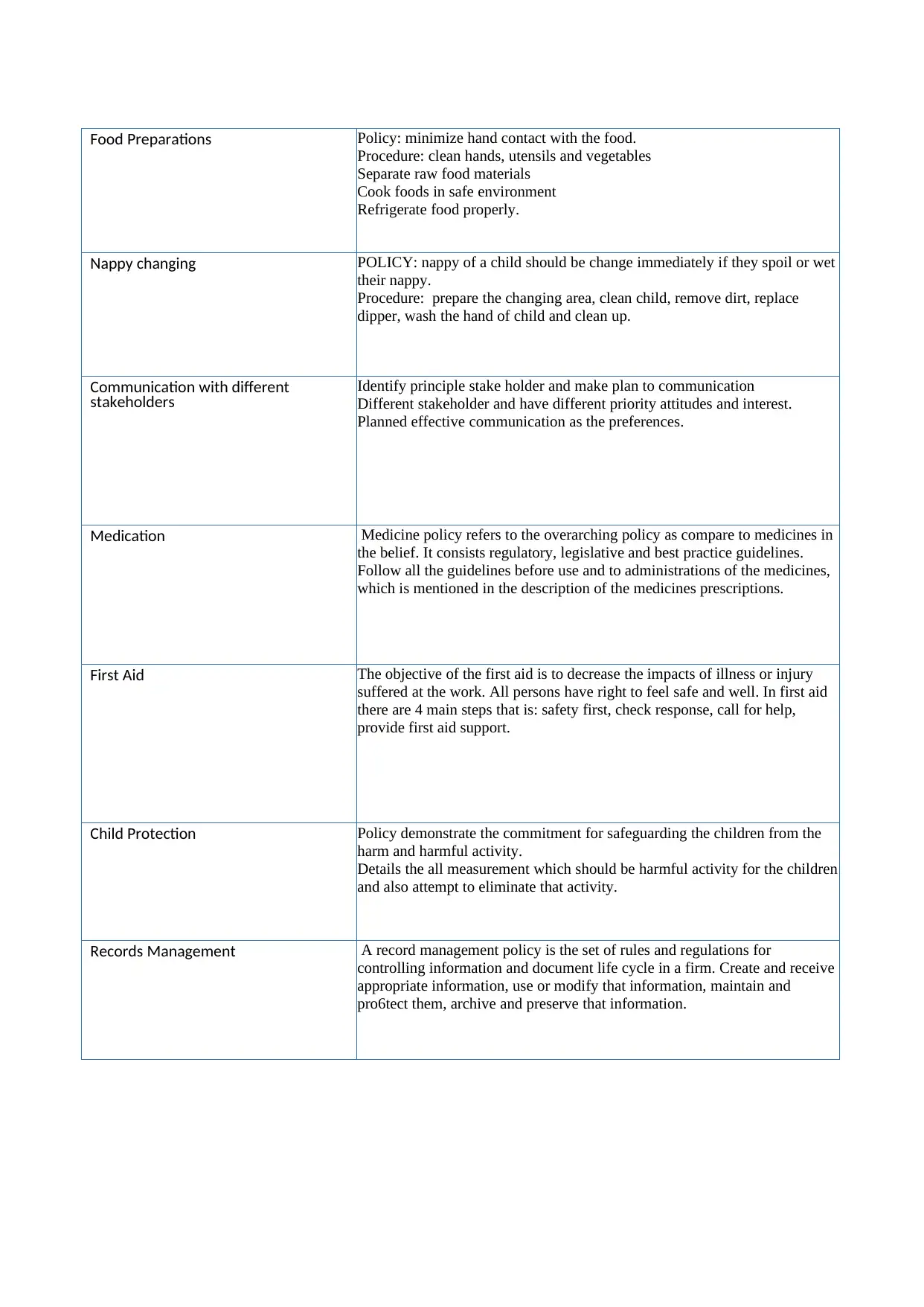
Food Preparations Policy: minimize hand contact with the food.
Procedure: clean hands, utensils and vegetables
Separate raw food materials
Cook foods in safe environment
Refrigerate food properly.
Nappy changing POLICY: nappy of a child should be change immediately if they spoil or wet
their nappy.
Procedure: prepare the changing area, clean child, remove dirt, replace
dipper, wash the hand of child and clean up.
Communication with different
stakeholders
Identify principle stake holder and make plan to communication
Different stakeholder and have different priority attitudes and interest.
Planned effective communication as the preferences.
Medication Medicine policy refers to the overarching policy as compare to medicines in
the belief. It consists regulatory, legislative and best practice guidelines.
Follow all the guidelines before use and to administrations of the medicines,
which is mentioned in the description of the medicines prescriptions.
First Aid The objective of the first aid is to decrease the impacts of illness or injury
suffered at the work. All persons have right to feel safe and well. In first aid
there are 4 main steps that is: safety first, check response, call for help,
provide first aid support.
Child Protection Policy demonstrate the commitment for safeguarding the children from the
harm and harmful activity.
Details the all measurement which should be harmful activity for the children
and also attempt to eliminate that activity.
Records Management A record management policy is the set of rules and regulations for
controlling information and document life cycle in a firm. Create and receive
appropriate information, use or modify that information, maintain and
pro6tect them, archive and preserve that information.
Procedure: clean hands, utensils and vegetables
Separate raw food materials
Cook foods in safe environment
Refrigerate food properly.
Nappy changing POLICY: nappy of a child should be change immediately if they spoil or wet
their nappy.
Procedure: prepare the changing area, clean child, remove dirt, replace
dipper, wash the hand of child and clean up.
Communication with different
stakeholders
Identify principle stake holder and make plan to communication
Different stakeholder and have different priority attitudes and interest.
Planned effective communication as the preferences.
Medication Medicine policy refers to the overarching policy as compare to medicines in
the belief. It consists regulatory, legislative and best practice guidelines.
Follow all the guidelines before use and to administrations of the medicines,
which is mentioned in the description of the medicines prescriptions.
First Aid The objective of the first aid is to decrease the impacts of illness or injury
suffered at the work. All persons have right to feel safe and well. In first aid
there are 4 main steps that is: safety first, check response, call for help,
provide first aid support.
Child Protection Policy demonstrate the commitment for safeguarding the children from the
harm and harmful activity.
Details the all measurement which should be harmful activity for the children
and also attempt to eliminate that activity.
Records Management A record management policy is the set of rules and regulations for
controlling information and document life cycle in a firm. Create and receive
appropriate information, use or modify that information, maintain and
pro6tect them, archive and preserve that information.
⊘ This is a preview!⊘
Do you want full access?
Subscribe today to unlock all pages.

Trusted by 1+ million students worldwide
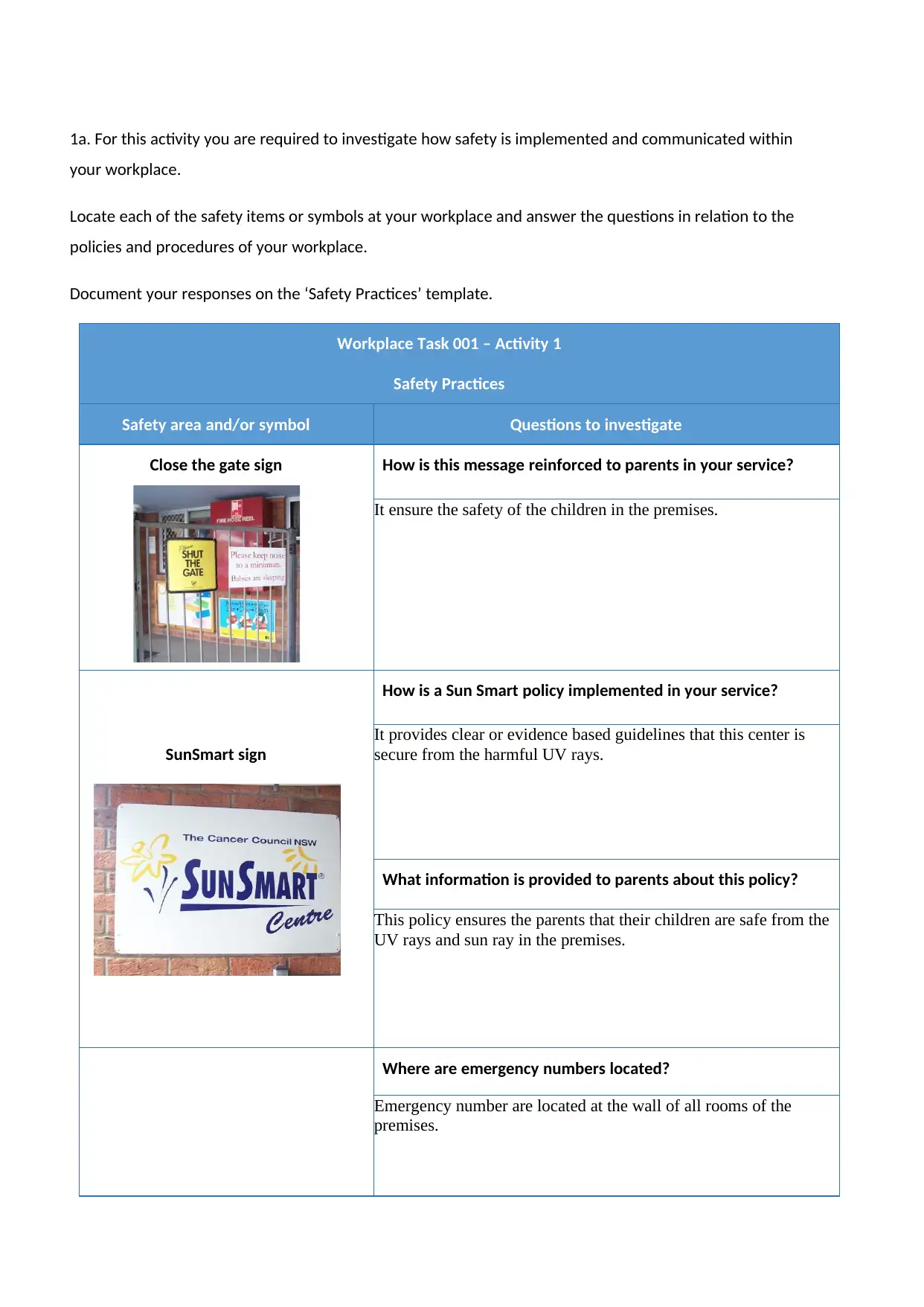
1a. For this activity you are required to investigate how safety is implemented and communicated within
your workplace.
Locate each of the safety items or symbols at your workplace and answer the questions in relation to the
policies and procedures of your workplace.
Document your responses on the ‘Safety Practices’ template.
Workplace Task 001 – Activity 1
Safety Practices
Safety area and/or symbol Questions to investigate
Close the gate sign How is this message reinforced to parents in your service?
It ensure the safety of the children in the premises.
SunSmart sign
How is a Sun Smart policy implemented in your service?
It provides clear or evidence based guidelines that this center is
secure from the harmful UV rays.
What information is provided to parents about this policy?
This policy ensures the parents that their children are safe from the
UV rays and sun ray in the premises.
Where are emergency numbers located?
Emergency number are located at the wall of all rooms of the
premises.
your workplace.
Locate each of the safety items or symbols at your workplace and answer the questions in relation to the
policies and procedures of your workplace.
Document your responses on the ‘Safety Practices’ template.
Workplace Task 001 – Activity 1
Safety Practices
Safety area and/or symbol Questions to investigate
Close the gate sign How is this message reinforced to parents in your service?
It ensure the safety of the children in the premises.
SunSmart sign
How is a Sun Smart policy implemented in your service?
It provides clear or evidence based guidelines that this center is
secure from the harmful UV rays.
What information is provided to parents about this policy?
This policy ensures the parents that their children are safe from the
UV rays and sun ray in the premises.
Where are emergency numbers located?
Emergency number are located at the wall of all rooms of the
premises.
Paraphrase This Document
Need a fresh take? Get an instant paraphrase of this document with our AI Paraphraser
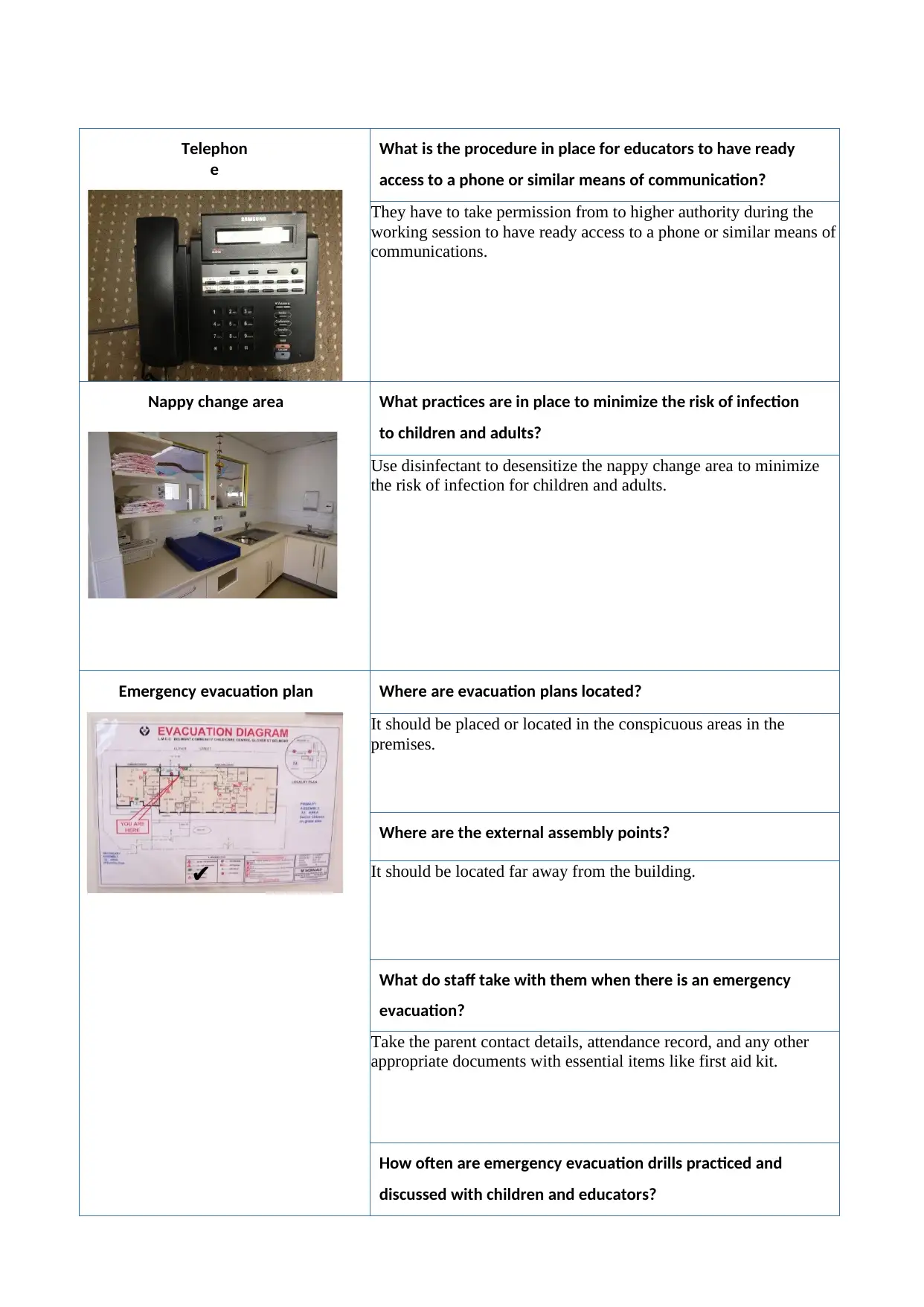
Telephon
e
What is the procedure in place for educators to have ready
access to a phone or similar means of communication?
They have to take permission from to higher authority during the
working session to have ready access to a phone or similar means of
communications.
Nappy change area What practices are in place to minimize the risk of infection
to children and adults?
Use disinfectant to desensitize the nappy change area to minimize
the risk of infection for children and adults.
Emergency evacuation plan
✔
Where are evacuation plans located?
It should be placed or located in the conspicuous areas in the
premises.
Where are the external assembly points?
It should be located far away from the building.
What do staff take with them when there is an emergency
evacuation?
Take the parent contact details, attendance record, and any other
appropriate documents with essential items like first aid kit.
How often are emergency evacuation drills practiced and
discussed with children and educators?
e
What is the procedure in place for educators to have ready
access to a phone or similar means of communication?
They have to take permission from to higher authority during the
working session to have ready access to a phone or similar means of
communications.
Nappy change area What practices are in place to minimize the risk of infection
to children and adults?
Use disinfectant to desensitize the nappy change area to minimize
the risk of infection for children and adults.
Emergency evacuation plan
✔
Where are evacuation plans located?
It should be placed or located in the conspicuous areas in the
premises.
Where are the external assembly points?
It should be located far away from the building.
What do staff take with them when there is an emergency
evacuation?
Take the parent contact details, attendance record, and any other
appropriate documents with essential items like first aid kit.
How often are emergency evacuation drills practiced and
discussed with children and educators?
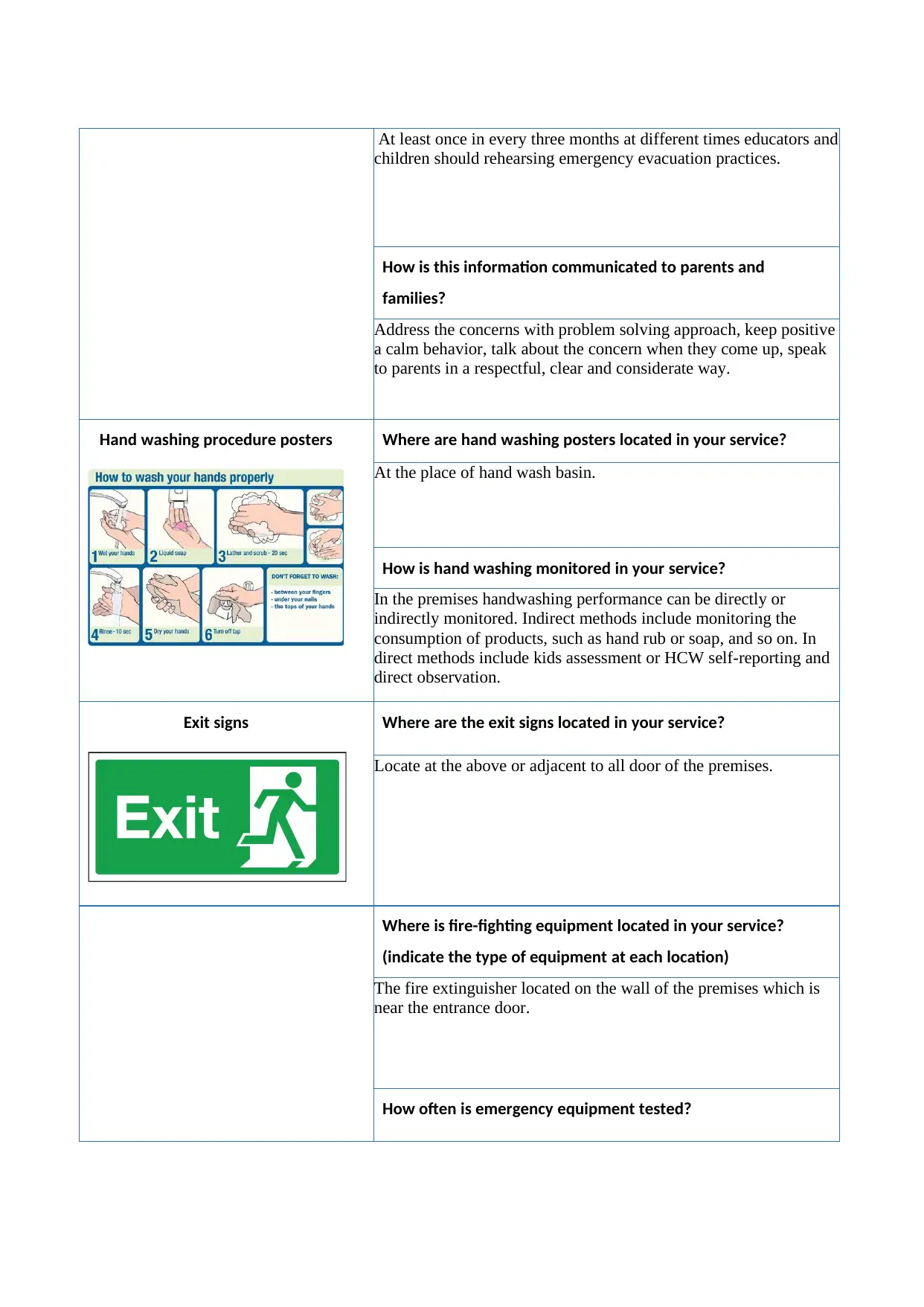
At least once in every three months at different times educators and
children should rehearsing emergency evacuation practices.
How is this information communicated to parents and
families?
Address the concerns with problem solving approach, keep positive
a calm behavior, talk about the concern when they come up, speak
to parents in a respectful, clear and considerate way.
Hand washing procedure posters Where are hand washing posters located in your service?
At the place of hand wash basin.
How is hand washing monitored in your service?
In the premises handwashing performance can be directly or
indirectly monitored. Indirect methods include monitoring the
consumption of products, such as hand rub or soap, and so on. In
direct methods include kids assessment or HCW self-reporting and
direct observation.
Exit signs Where are the exit signs located in your service?
Locate at the above or adjacent to all door of the premises.
Where is fire-fighting equipment located in your service?
(indicate the type of equipment at each location)
The fire extinguisher located on the wall of the premises which is
near the entrance door.
How often is emergency equipment tested?
children should rehearsing emergency evacuation practices.
How is this information communicated to parents and
families?
Address the concerns with problem solving approach, keep positive
a calm behavior, talk about the concern when they come up, speak
to parents in a respectful, clear and considerate way.
Hand washing procedure posters Where are hand washing posters located in your service?
At the place of hand wash basin.
How is hand washing monitored in your service?
In the premises handwashing performance can be directly or
indirectly monitored. Indirect methods include monitoring the
consumption of products, such as hand rub or soap, and so on. In
direct methods include kids assessment or HCW self-reporting and
direct observation.
Exit signs Where are the exit signs located in your service?
Locate at the above or adjacent to all door of the premises.
Where is fire-fighting equipment located in your service?
(indicate the type of equipment at each location)
The fire extinguisher located on the wall of the premises which is
near the entrance door.
How often is emergency equipment tested?
⊘ This is a preview!⊘
Do you want full access?
Subscribe today to unlock all pages.

Trusted by 1+ million students worldwide
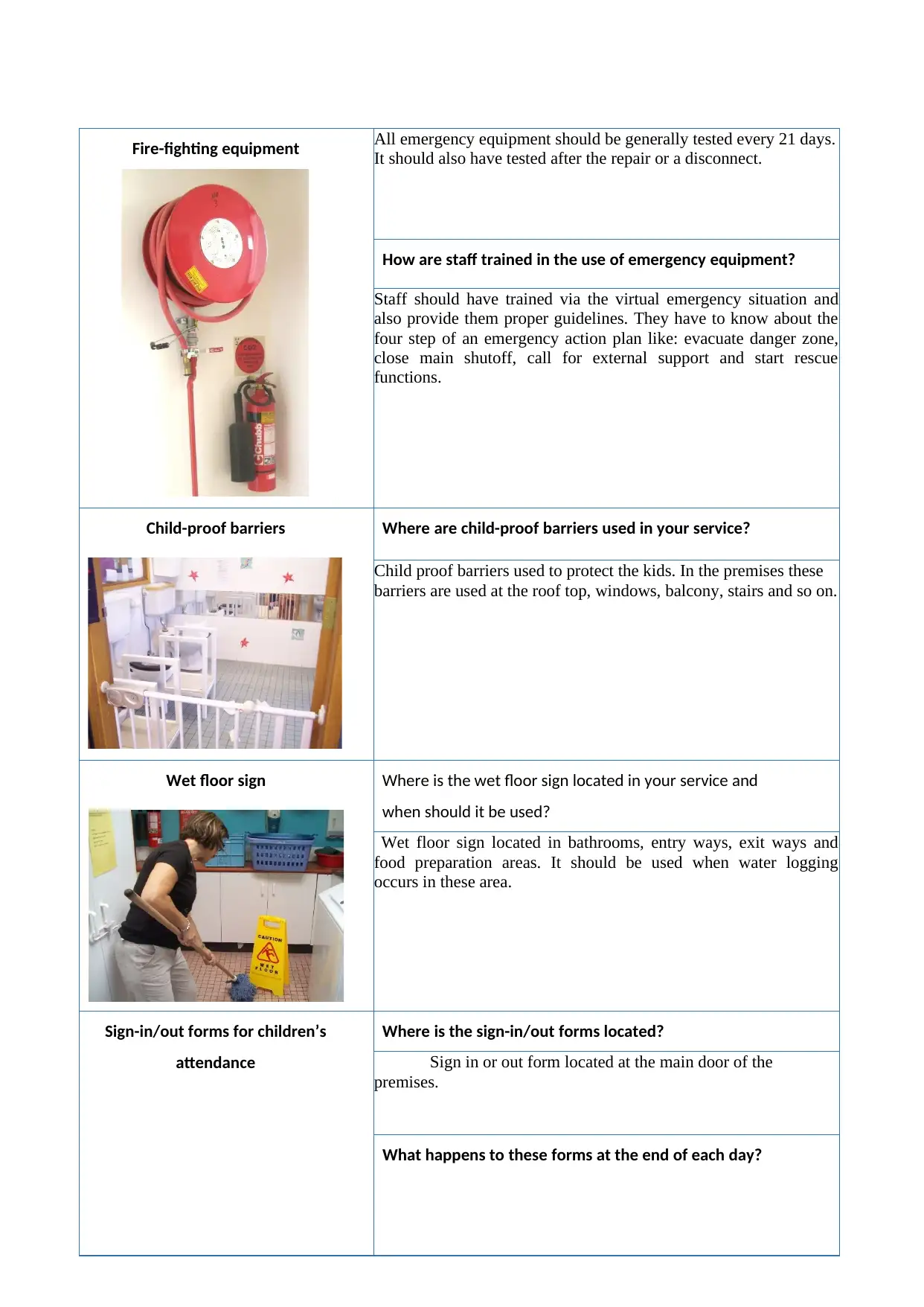
Fire-fighting equipment All emergency equipment should be generally tested every 21 days.
It should also have tested after the repair or a disconnect.
How are staff trained in the use of emergency equipment?
Staff should have trained via the virtual emergency situation and
also provide them proper guidelines. They have to know about the
four step of an emergency action plan like: evacuate danger zone,
close main shutoff, call for external support and start rescue
functions.
Child-proof barriers Where are child-proof barriers used in your service?
Child proof barriers used to protect the kids. In the premises these
barriers are used at the roof top, windows, balcony, stairs and so on.
Wet floor sign Where is the wet floor sign located in your service and
when should it be used?
Wet floor sign located in bathrooms, entry ways, exit ways and
food preparation areas. It should be used when water logging
occurs in these area.
Sign-in/out forms for children’s
attendance
Where is the sign-in/out forms located?
Sign in or out form located at the main door of the
premises.
What happens to these forms at the end of each day?
It should also have tested after the repair or a disconnect.
How are staff trained in the use of emergency equipment?
Staff should have trained via the virtual emergency situation and
also provide them proper guidelines. They have to know about the
four step of an emergency action plan like: evacuate danger zone,
close main shutoff, call for external support and start rescue
functions.
Child-proof barriers Where are child-proof barriers used in your service?
Child proof barriers used to protect the kids. In the premises these
barriers are used at the roof top, windows, balcony, stairs and so on.
Wet floor sign Where is the wet floor sign located in your service and
when should it be used?
Wet floor sign located in bathrooms, entry ways, exit ways and
food preparation areas. It should be used when water logging
occurs in these area.
Sign-in/out forms for children’s
attendance
Where is the sign-in/out forms located?
Sign in or out form located at the main door of the
premises.
What happens to these forms at the end of each day?
Paraphrase This Document
Need a fresh take? Get an instant paraphrase of this document with our AI Paraphraser
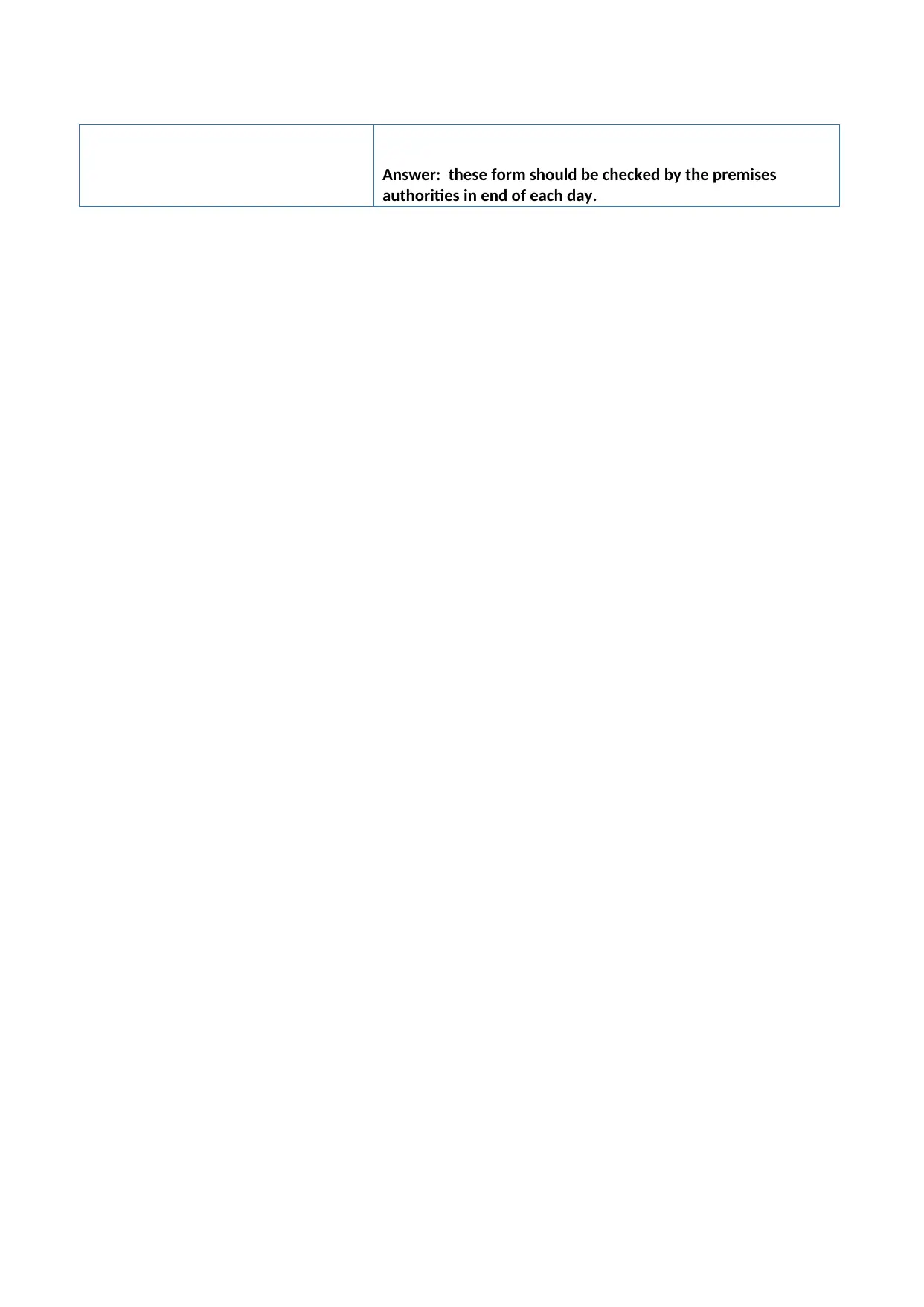
Answer: these form should be checked by the premises
authorities in end of each day.
authorities in end of each day.
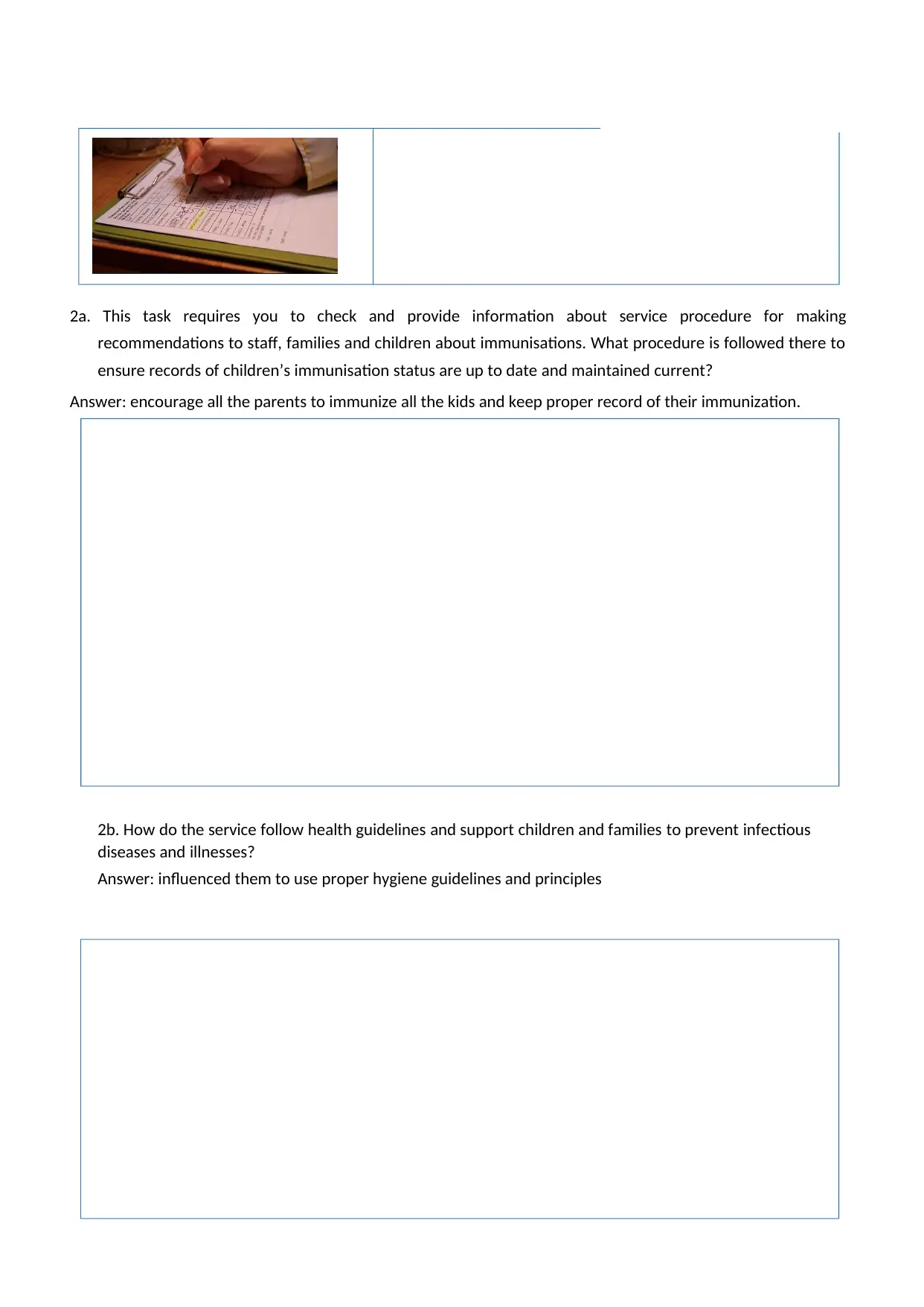
2a. This task requires you to check and provide information about service procedure for making
recommendations to staff, families and children about immunisations. What procedure is followed there to
ensure records of children’s immunisation status are up to date and maintained current?
Answer: encourage all the parents to immunize all the kids and keep proper record of their immunization.
2b. How do the service follow health guidelines and support children and families to prevent infectious
diseases and illnesses?
Answer: influenced them to use proper hygiene guidelines and principles
recommendations to staff, families and children about immunisations. What procedure is followed there to
ensure records of children’s immunisation status are up to date and maintained current?
Answer: encourage all the parents to immunize all the kids and keep proper record of their immunization.
2b. How do the service follow health guidelines and support children and families to prevent infectious
diseases and illnesses?
Answer: influenced them to use proper hygiene guidelines and principles
⊘ This is a preview!⊘
Do you want full access?
Subscribe today to unlock all pages.

Trusted by 1+ million students worldwide
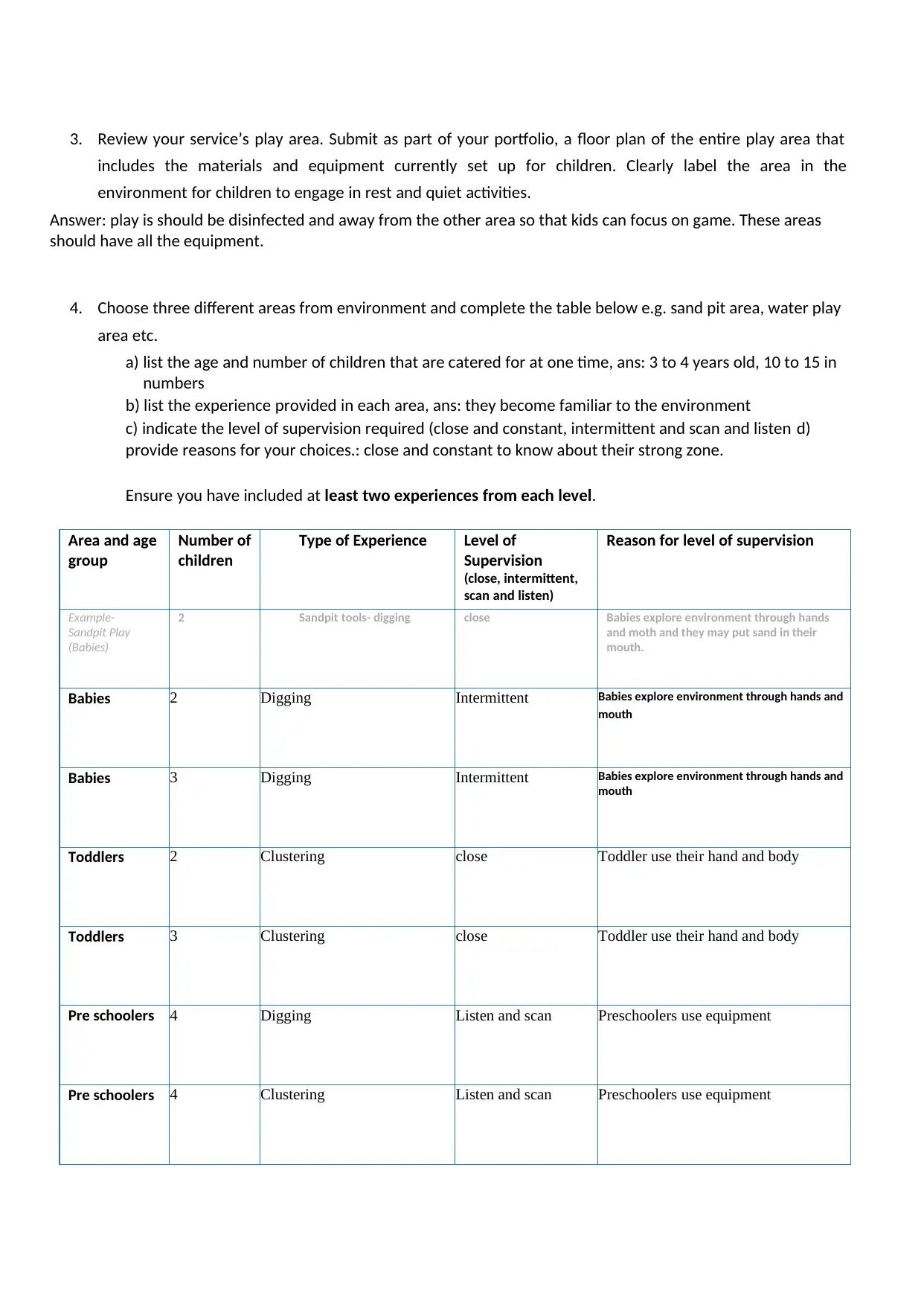
3. Review your service’s play area. Submit as part of your portfolio, a floor plan of the entire play area that
includes the materials and equipment currently set up for children. Clearly label the area in the
environment for children to engage in rest and quiet activities.
Answer: play is should be disinfected and away from the other area so that kids can focus on game. These areas
should have all the equipment.
4. Choose three different areas from environment and complete the table below e.g. sand pit area, water play
area etc.
a) list the age and number of children that are catered for at one time, ans: 3 to 4 years old, 10 to 15 in
numbers
b) list the experience provided in each area, ans: they become familiar to the environment
c) indicate the level of supervision required (close and constant, intermittent and scan and listen d)
provide reasons for your choices.: close and constant to know about their strong zone.
Ensure you have included at least two experiences from each level.
Area and age
group
Number of
children
Type of Experience Level of
Supervision
(close, intermittent,
scan and listen)
Reason for level of supervision
Example-
Sandpit Play
(Babies)
2 Sandpit tools- digging close Babies explore environment through hands
and moth and they may put sand in their
mouth.
Babies 2 Digging Intermittent Babies explore environment through hands and
mouth
Babies 3 Digging Intermittent Babies explore environment through hands and
mouth
Toddlers 2 Clustering close Toddler use their hand and body
Toddlers 3 Clustering close Toddler use their hand and body
Pre schoolers 4 Digging Listen and scan Preschoolers use equipment
Pre schoolers 4 Clustering Listen and scan Preschoolers use equipment
includes the materials and equipment currently set up for children. Clearly label the area in the
environment for children to engage in rest and quiet activities.
Answer: play is should be disinfected and away from the other area so that kids can focus on game. These areas
should have all the equipment.
4. Choose three different areas from environment and complete the table below e.g. sand pit area, water play
area etc.
a) list the age and number of children that are catered for at one time, ans: 3 to 4 years old, 10 to 15 in
numbers
b) list the experience provided in each area, ans: they become familiar to the environment
c) indicate the level of supervision required (close and constant, intermittent and scan and listen d)
provide reasons for your choices.: close and constant to know about their strong zone.
Ensure you have included at least two experiences from each level.
Area and age
group
Number of
children
Type of Experience Level of
Supervision
(close, intermittent,
scan and listen)
Reason for level of supervision
Example-
Sandpit Play
(Babies)
2 Sandpit tools- digging close Babies explore environment through hands
and moth and they may put sand in their
mouth.
Babies 2 Digging Intermittent Babies explore environment through hands and
mouth
Babies 3 Digging Intermittent Babies explore environment through hands and
mouth
Toddlers 2 Clustering close Toddler use their hand and body
Toddlers 3 Clustering close Toddler use their hand and body
Pre schoolers 4 Digging Listen and scan Preschoolers use equipment
Pre schoolers 4 Clustering Listen and scan Preschoolers use equipment
Paraphrase This Document
Need a fresh take? Get an instant paraphrase of this document with our AI Paraphraser
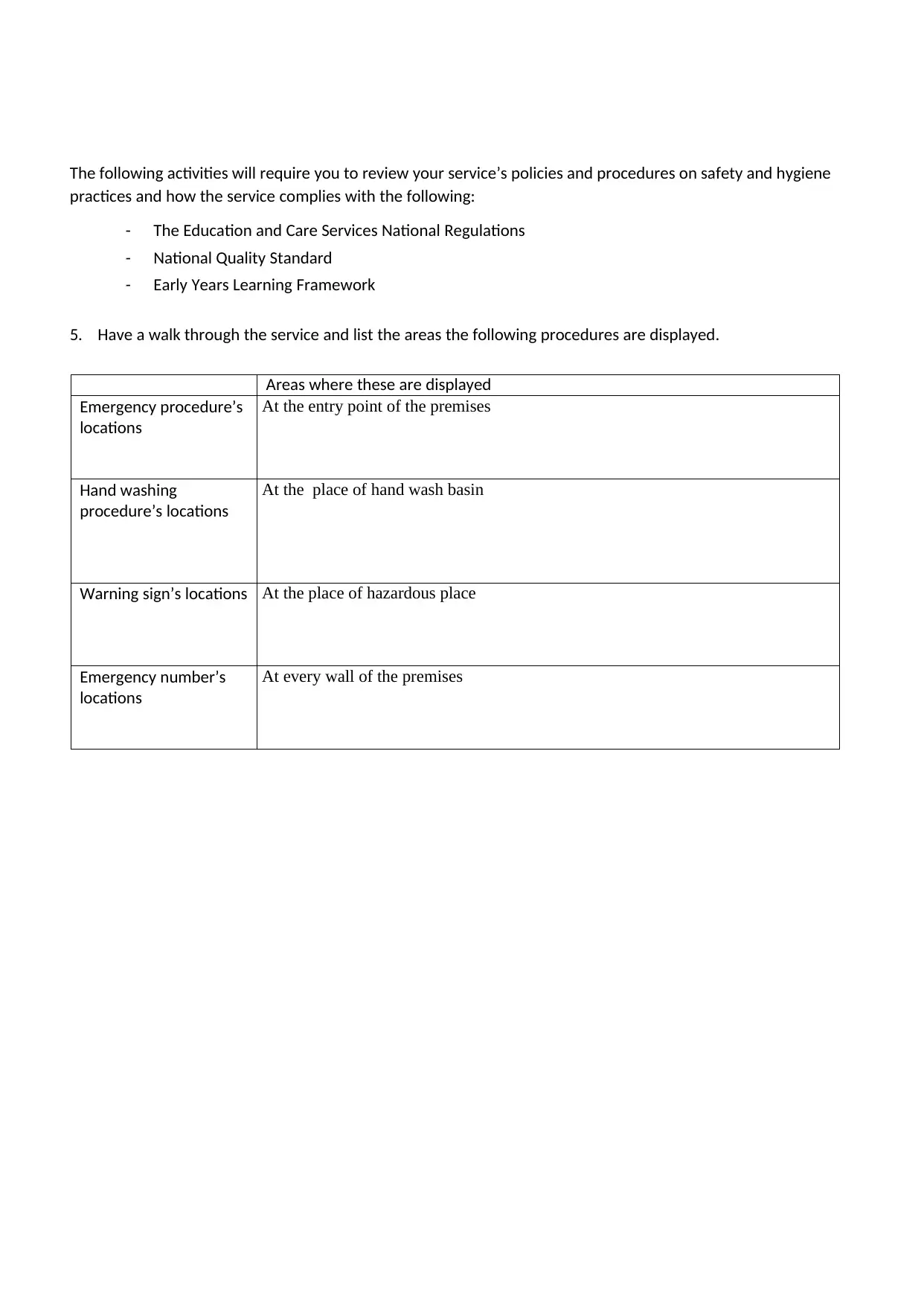
The following activities will require you to review your service’s policies and procedures on safety and hygiene
practices and how the service complies with the following:
- The Education and Care Services National Regulations
- National Quality Standard
- Early Years Learning Framework
5. Have a walk through the service and list the areas the following procedures are displayed.
Areas where these are displayed
Emergency procedure’s
locations
At the entry point of the premises
Hand washing
procedure’s locations
At the place of hand wash basin
Warning sign’s locations At the place of hazardous place
Emergency number’s
locations
At every wall of the premises
practices and how the service complies with the following:
- The Education and Care Services National Regulations
- National Quality Standard
- Early Years Learning Framework
5. Have a walk through the service and list the areas the following procedures are displayed.
Areas where these are displayed
Emergency procedure’s
locations
At the entry point of the premises
Hand washing
procedure’s locations
At the place of hand wash basin
Warning sign’s locations At the place of hazardous place
Emergency number’s
locations
At every wall of the premises
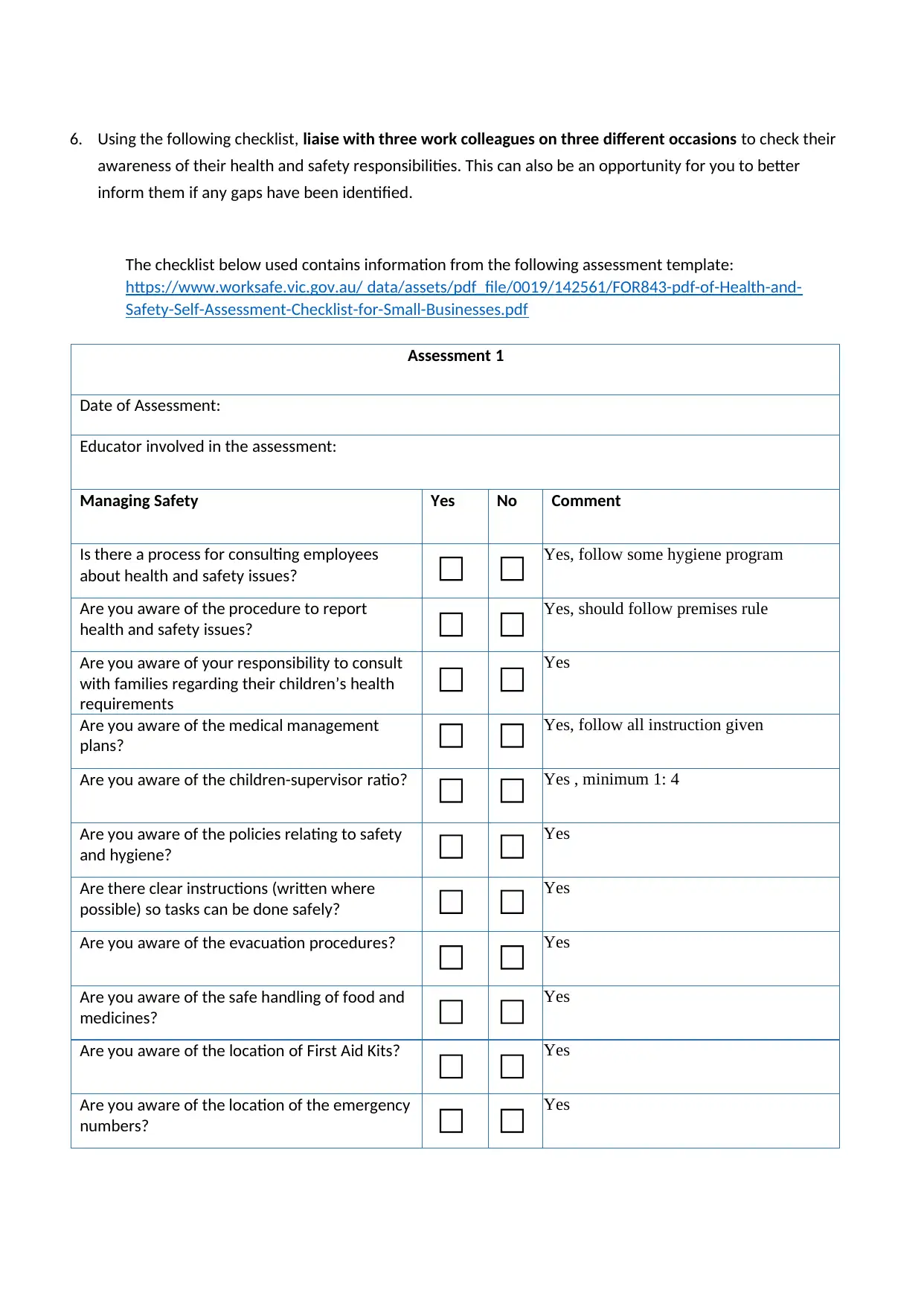
6. Using the following checklist, liaise with three work colleagues on three different occasions to check their
awareness of their health and safety responsibilities. This can also be an opportunity for you to better
inform them if any gaps have been identified.
The checklist below used contains information from the following assessment template:
https://www.worksafe.vic.gov.au/ data/assets/pdf_file/0019/142561/FOR843-pdf-of-Health-and-
Safety-Self-Assessment-Checklist-for-Small-Businesses.pdf
Assessment 1
Date of Assessment:
Educator involved in the assessment:
Managing Safety Yes No Comment
Is there a process for consulting employees
about health and safety issues?
Yes, follow some hygiene program
Are you aware of the procedure to report
health and safety issues?
Yes, should follow premises rule
Are you aware of your responsibility to consult
with families regarding their children’s health
requirements
Yes
Are you aware of the medical management
plans?
Yes, follow all instruction given
Are you aware of the children-supervisor ratio? Yes , minimum 1: 4
Are you aware of the policies relating to safety
and hygiene?
Yes
Are there clear instructions (written where
possible) so tasks can be done safely?
Yes
Are you aware of the evacuation procedures? Yes
Are you aware of the safe handling of food and
medicines?
Yes
Are you aware of the location of First Aid Kits? Yes
Are you aware of the location of the emergency
numbers?
Yes
awareness of their health and safety responsibilities. This can also be an opportunity for you to better
inform them if any gaps have been identified.
The checklist below used contains information from the following assessment template:
https://www.worksafe.vic.gov.au/ data/assets/pdf_file/0019/142561/FOR843-pdf-of-Health-and-
Safety-Self-Assessment-Checklist-for-Small-Businesses.pdf
Assessment 1
Date of Assessment:
Educator involved in the assessment:
Managing Safety Yes No Comment
Is there a process for consulting employees
about health and safety issues?
Yes, follow some hygiene program
Are you aware of the procedure to report
health and safety issues?
Yes, should follow premises rule
Are you aware of your responsibility to consult
with families regarding their children’s health
requirements
Yes
Are you aware of the medical management
plans?
Yes, follow all instruction given
Are you aware of the children-supervisor ratio? Yes , minimum 1: 4
Are you aware of the policies relating to safety
and hygiene?
Yes
Are there clear instructions (written where
possible) so tasks can be done safely?
Yes
Are you aware of the evacuation procedures? Yes
Are you aware of the safe handling of food and
medicines?
Yes
Are you aware of the location of First Aid Kits? Yes
Are you aware of the location of the emergency
numbers?
Yes
⊘ This is a preview!⊘
Do you want full access?
Subscribe today to unlock all pages.

Trusted by 1+ million students worldwide
1 out of 29
Related Documents
Your All-in-One AI-Powered Toolkit for Academic Success.
+13062052269
info@desklib.com
Available 24*7 on WhatsApp / Email
![[object Object]](/_next/static/media/star-bottom.7253800d.svg)
Unlock your academic potential
Copyright © 2020–2025 A2Z Services. All Rights Reserved. Developed and managed by ZUCOL.





